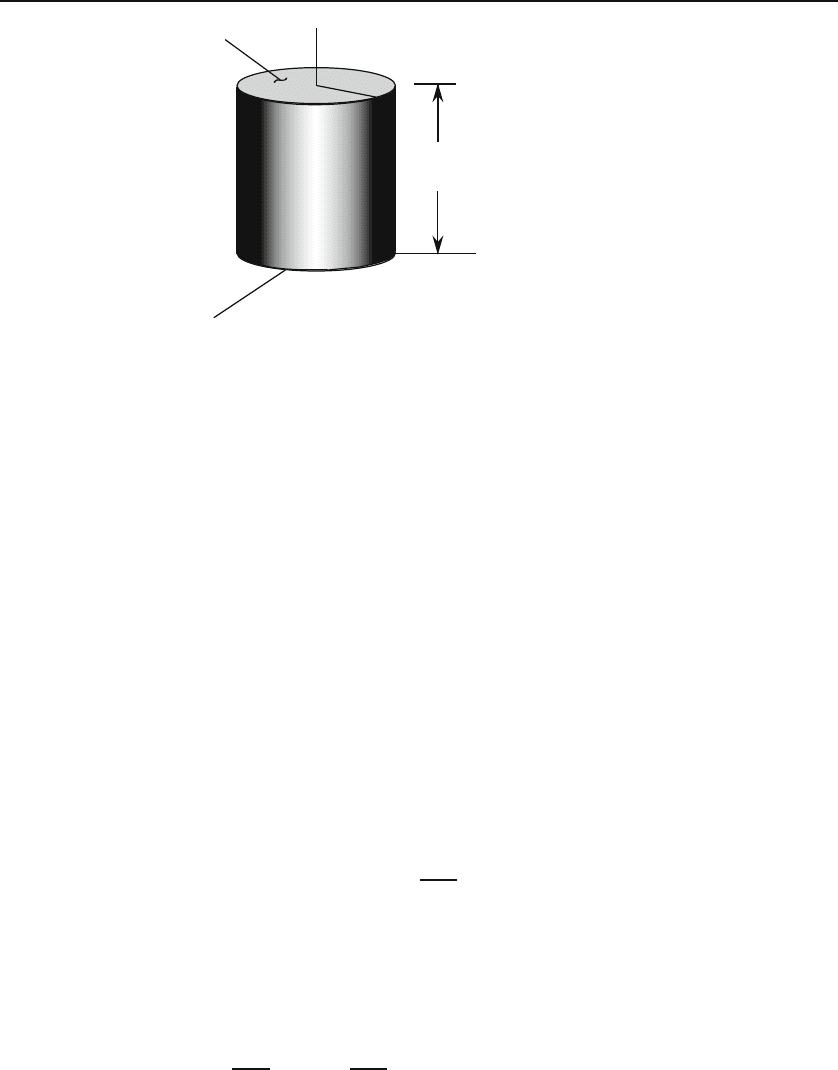Hassani S. Mathematical Methods: For Students of Physics and Related Fields
Подождите немного. Документ загружается.


648 Laplace’s Equation: Cylindrical Coordinates
where the prime indicates differentiation with respect to ρ. Now integrate
this equation with respect to ρ from some initial value (say a) to some final
value (say b)toobtain
[ρ(fg
− gf
)]
b
a
=(k
2
− l
2
)
#
b
a
ρf(ρ)g(ρ) dρ.
In all physical applications a and b can be chosen to make the LHS vanish.
Then, substituting for f and g in terms of Bessel functions, we get
(k
2
− l
2
)
#
b
a
ρJ
m
(kρ)J
m
(lρ) dρ =0.
It follows that if k = l, then the integral vanishes, i.e.,
#
b
a
ρJ
m
(kρ)J
m
(lρ) dρ =0 if k = l. (27.20)
This is the orthogonality relation for Bessel functions also derived in Example
24.5.3.
To complete the orthogonality relation, we must also address the case when
k = l. This involves the evaluation of the integral
ρJ
2
m
(kρ) dρ,which,upon
the change of variable x ≡ kρ, reduces to (
xJ
2
m
(x) dx)/k
2
.Byintegration
by parts, we have
I ≡
#
J
2
m
(x)
u
xdx
dv
=
1
2
x
2
J
2
m
(x) −
#
J
m
(x)J
m
(x)x
2
dx.
In the last integral, substitute for x
2
J
m
(x) from the Bessel DE (27.6)—using
x instead of v:
x
2
J
m
(x)=m
2
J
m
(x) −xJ
m
(x) −x
2
J
m
(x).
Therefore,
I =
1
2
x
2
J
2
m
(x) −
#
J
m
(x)[m
2
J
m
(x)
=−(
1
2
x
2
[J
m
(x)]
2
)
−xJ
m
(x) −x
2
J
m
(x)] dx
=
1
2
x
2
J
2
m
(x) − m
2
#
=
1
2
[J
2
m
(x)]
J
m
(x)J
m
(x) dx +
1
2
#
d
dx
x
2
[J
m
(x)]
2
!
dx
=
1
2
x
2
J
2
m
(x) −
1
2
m
2
J
2
m
(x)+
1
2
x
2
[J
m
(x)]
2
.
Returning back to ρ, we obtain the indefinite integral
#
ρJ
2
m
(kρ) dρ =
I
k
2
=
1
2
ρ
2
−
m
2
k
2
J
2
m
(kρ)+
1
2
ρ
2
[J
m
(kρ)]
2
. (27.21)

27.4 Properties of the Bessel Functions 649
In most applications, the lower limit of integration is zero and the upper limit
is a positive number a. The RHS of (27.21) vanishes at the lower limit because
of the following reason. The first term vanishes at ρ = 0 because J
m
(0) = 0
for all m>0 as is evident from the series expansion (27.10). For m =0(and
ρ = 0), the parentheses in the first term of (27.21) vanishes. So, the first
term is zero for all m ≥ 0 at the lower limit of integration. The second term
vanishes due to the presence of ρ
2
.Thus,weobtain
#
a
0
ρJ
2
m
(kρ) dρ =
1
2
a
2
−
m
2
k
2
J
2
m
(ka)+
1
2
a
2
[J
m
(ka)]
2
(27.22)
for all m ≥ 0 and, by (27.14), also for all negative integers. As mentioned
earlier, we shall confine our discussion to Bessel functions of integer orders.
It is customary to simplify the RHS of (27.22) by choosing k in such a way
that J
m
(ka) = 0, i.e., that ka is a root of the Bessel function of order m.In
general, there are infinitely many roots. So, let x
mn
denote the nth root of
J
m
(x). Then,
ka = x
mn
⇒ k =
x
mn
a
,n=1, 2,...,
and if we use Equation (27.17), we obtain
#
a
0
ρJ
2
m
(x
mn
ρ/a) dρ =
1
2
a
2
[J
m+1
(x
mn
)]
2
. (27.23)
Equations (27.20) and (27.23) can be combined into a single equation using
the Kronecker delta:
orthogonality
relations involving
Bessel functions
Box 27.4.1. The Bessel functions of integer order satisfy the orthogonal-
ity relations
#
a
0
J
m
(x
mn
ρ/a)J
m
(x
mk
ρ/a)ρdρ =
1
2
a
2
J
2
m+1
(x
mn
)δ
kn
, (27.24)
where a>0 and x
mn
is the nth root of J
m
(x).
27.4.4 Generating Function
Just as in the case of Legendre polynomials, Bessel functions of integer order
have a generating function, i.e., there exists a function g(x, t) such that
g(x, t)=
∞
n=−∞
t
n
J
n
(x). (27.25)
To find g, start with the recurrence relation
J
m−1
(x)+J
m+1
(x)=
2m
x
J
m
(x),

650 Laplace’s Equation: Cylindrical Coordinates
multiply it by t
m
,andsumoverallm to obtain
∞
m=−∞
t
m
J
m−1
(x)+
∞
m=−∞
t
m
J
m+1
(x)=
2
x
∞
m=−∞
mt
m
J
m
(x). (27.26)
The first sum can be written as
∞
m=−∞
t
m
J
m−1
(x)=t
∞
m=−∞
t
m−1
J
m−1
(x)=t
∞
n=−∞
t
n
J
n
(x)=tg(x, t),
where we substituted the dummy index n = m −1form. Similarly
∞
m=−∞
t
m
J
m+1
(x)=
1
t
∞
m=−∞
t
m+1
J
m+1
(x)=
1
t
g(x, t)
and
2
x
∞
m=−∞
mt
m
J
m
(x)=
2t
x
∞
m=−∞
mt
m−1
J
m
(x)=
2t
x
∂g
∂t
.
It follows from Equation (27.26) that
t +
1
t
g(x, t)=
2t
x
∂g
∂t
,
or
x
2
1+
1
t
2
dt =
dg
g
,
where x is assumed to be a constant because we have been differentiating with
respect to t. Integrating both sides gives
#
x
2
1+
1
t
2
dt
=
x
2
(
t−
1
t
)
=lng +lnφ(x),
where the last term is the “constant” of integration. Thus,
g(x, t)=φ(x)exp
x
2
t −
1
t
.
To determine φ(x), we note that
g(x, t)=φ(x)e
xt/2
e
−x/2t
= φ(x)
∞
n=0
(xt/2)
n
n!
∞
m=0
(−x/2t)
m
m!
= φ(x)
∞
n,m=0
(−1)
m
n!m!
x
2
n+m
t
n−m
.

27.4 Properties of the Bessel Functions 651
In the last double sum, collect all terms whose power of t is zero, and call the
sum S
0
. This is obtained by setting n = m. Then,
S
0
= φ(x)
∞
n=0
(−1)
n
n!n!
x
2
2n
= φ(x)J
0
(x),
where we used Equation (27.10) with s = 0. But (27.25) shows that the
collection of all terms whose power of t is zero is simply J
0
(x). Thus, S
0
=
J
0
(x), and φ(x) = 1. This leads to the final form of the Bessel generating
function:
generating
function for Bessel
functions
g(x, t)=exp
x
2
t −
1
t
=
∞
n=−∞
t
n
J
n
(x). (27.27)
Example 27.4.1.
The generating function for Bessel functions can be used to
obtain a useful identity. First we note that
g(x + y, t)=g(x, t)g(y,t)
as the reader may easily verify. Expanding each side gives
∞
n=−∞
t
n
J
n
(x + y)=
∞
k=−∞
t
k
J
k
(x)
∞
m=−∞
t
m
J
m
(y)=
∞
k=−∞
∞
m=−∞
t
k+m
J
k
(x)J
m
(y).
In the last double sum, let n = k+m,sothatk = n−m. Since there is no limitation
on the value of either of the dummy indices, the limits of the new indices n and m
are still −∞ and ∞. Therefore,
∞
n=−∞
t
n
J
n
(x + y)=
∞
n=−∞
∞
m=−∞
t
n
J
n−m
(x)J
m
(y)
=
∞
n=−∞
t
n
∞
m=−∞
J
n−m
(x)J
m
(y)
.
Since each power of t should have the same coefficient on both sides, we obtain the
so-called addition theorem for Bessel functions: addition theorem
for Bessel
functions
J
n
(x + y)=
∞
m=−∞
J
n−m
(x)J
m
(y)=
∞
m=−∞
J
m
(x)J
n−m
(y), (27.28)
where the last equality follows from the symmetry of J
n
(x + y) under the exchange
of x and y.
The Bessel generating function can also lead to some very important iden-
tities. In Equation (27.27), let t = e
iθ
and use (18.14) to obtain
e
ix sin θ
=
∞
n=−∞
e
inθ
J
n
(x). (27.29)

652 Laplace’s Equation: Cylindrical Coordinates
This is a Fourier series expansion in θ—as given in (18.20)—whose coefficients
are Bessel functions. To find these coefficients, we multiply both sides by
e
−imθ
and integrate from −π to π [see also Equation (18.22)]. The LHS
gives
LHS =
#
π
−π
e
ix sin θ
e
−imθ
dθ =
#
π
−π
e
i(x sin θ−mθ)
dθ.
For the RHS, we obtain
∞
n=−∞
#
π
−π
e
i(n−m)θ
dθ
J
n
(x)=2πJ
m
(x),
where we used the easily verifiable result [also see Equation (18.21)]:
#
π
−π
e
i(n−m)θ
dθ =
0
0ifn = m
2π if n = m
=2πδ
mn
.
Equating the RHS and the LHS, we obtain
integral
representation of
the Bessel
function
J
m
(x)=
1
2π
#
π
−π
e
i(x sin θ−mθ)
dθ. (27.30)
The reader may check that this can be reduced to
J
m
(x)=
1
π
#
π
0
cos(x sin θ − mθ) dθ (27.31)
which is called Bessel’s integral.
Bessel’s integral
Bessel functions can be written in terms of the confluent hypergeometric
function. To see this, substitute R(v)=v
μ
e
−ηv
f(v)—with μ and η to be
determined—in Equation (27.6) to obtain
d
2
f
dv
2
+
2μ +1
v
− 2η
df
dv
+
μ
2
− m
2
v
2
−
η(2μ +1)
v
+ η
2
+1
f =0
which, if we set μ = m and η = i, reduces to
f
+
2m +1
v
− 2i
f
−
(2m +1)i
v
f =0. (27.32)
Making the further substitution 2iv = t, and multiplying out by t,weobtain
t
d
2
f
dt
2
+(2m +1− t)
df
dt
− (m +
1
2
)f =0
which is in the form of (11.27) with α = m +
1
2
and γ =2m + 1. Thus, Bessel
functions J
m
(x) can be written as constant multiples of x
m
e
−ix
Φ(m+
1
2
, 2m+relation between
Bessel functions
and confluent
hypergeometric
function
1; 2ix). In fact,
J
m
(x)=
1
Γ(m +1)
x
2
m
e
−ix
Φ(m +
1
2
, 2m +1;2ix). (27.33)

27.5 Expansions in Bessel Functions 653
27.5 Expansions in Bessel Functions
The orthogonality of Bessel functions can be useful in expanding other func-
tions in terms of them. The basic idea is similar to the expansion in Fourier
series and Legendre polynomials. If a function f(ρ) is defined in the interval
(0,a), then we may write
f(ρ)=
∞
n=1
c
n
J
m
(x
mn
ρ/a). (27.34)
The coefficients can be found by multiplying both sides by ρJ
m
(x
mk
ρ/a)and
integrating from zero to a. The reader may verify that this yields
c
n
=
2
a
2
J
2
m+1
(x
mn
)
#
a
0
f(ρ)J
m
(x
mn
ρ/a)ρdρ. (27.35)
Equations (27.34) and (27.35) are the analogues of Equations (10.38),
(10.40), (10.41), and (10.42) for Fourier series, and Equations (26.46) and
(26.47) for Legendre polynomials. Like those sets of equations, they can be
used to expand functions in terms of Bessel functions of a specific order.
Example 27.5.1.
The trigonometric functions can be expanded in Bessel func-
tions with very little effort. In fact, Equation (27.29) leads immediately to
e
ix
=
∞
n=−∞
i
n
J
n
(x)
or expansion of sine
and cosine in
Bessel functions
cos x + i sin x =
∞
k=−∞
i
2k
J
2k
(x)+
∞
k=−∞
i
2k+1
J
2k+1
(x),
wherewehaveseparatedtheevenandoddsums. Thefirstsumisrealandthe
second sum pure imaginary. Therefore,
cos x =
∞
k=−∞
(−1)
k
J
2k
(x)=
−1
k=−∞
(−1)
k
J
2k
(x)+J
0
(x)+
∞
k=1
(−1)
k
J
2k
(x).
The first sum can be written as
−1
k=−∞
(−1)
k
J
2k
(x)=
∞
k=1
(−1)
−k
J
−2k
(x)=
∞
k=1
(−1)
k
(−1)
2k
J
2k
(x)
=
∞
k=1
(−1)
k
J
2k
(x)
which is identical to the last sum. It follows that
cos x = J
0
(x)+2
∞
k=1
(−1)
k
J
2k
(x). (27.36)
Similarly,
sin x =2
∞
k=0
(−1)
k
J
2k+1
(x) (27.37)
as the reader is urged to verify.

654 Laplace’s Equation: Cylindrical Coordinates
If we square Equation (27.34), multiply by ρ, and integrate from zero to
a,weobtain
#
a
0
f
2
(ρ)ρdρ =
∞
n=1
∞
k=1
c
n
c
k
#
a
0
J
m
(x
mn
ρ/a)J
m
(x
mk
ρ/a)ρdρ
=
1
2
a
2
J
2
m+1
(x
mn
)δ
kn
by (27.24)
.
This leads to the so-called Parseval relation:
Parseval relation
#
a
0
f
2
(ρ)ρdρ =
1
2
a
2
∞
n=1
c
2
n
J
2
m+1
(x
mn
) (27.38)
for some m.Thism can be chosen to make the integrations as simple as
possible.
Example 27.5.2.
Let us find the expansion of ρ
k
in terms of Bessel functions.expansion of ρ
k
in
terms of Bessel
functions
Equations (27.35) and (27.18) suggest expanding in terms of J
k
(x)becausethe
integrals can be performed. Therefore, we write
ρ
k
=
∞
n=1
c
n
J
k
(x
kn
ρ/a),
where
c
n
=
2
a
2
J
2
k+1
(x
kn
)
#
a
0
ρ
k
J
k
(x
kn
ρ/a)ρdρ =
2
a
2
J
2
k+1
(x
kn
)
#
a
0
ρ
k+1
J
k
(x
kn
ρ/a) dρ.
Introducing y = x
kn
ρ/a in the integral gives
c
n
=
2a
k
x
k+2
kn
J
2
k+1
(x
kn
)
#
x
kn
0
y
k+1
J
k
(y) dy =
2a
k
x
kn
J
k+1
(x
kn
)
,
where we used (27.18) with m replaced by k +1. Thus, we have
ρ
k
=2a
k
∞
n=1
J
k
(x
kn
ρ/a)
x
kn
J
k+1
(x
kn
)
.
27.6 Physical Examples
Our discussion of Laplace’s equation has led us to believe that trigonometric
functions and Legendre polynomials are, respectively, the “natural” functions
of Cartesian and spherical geometries. It is of no surprise now to learn that
Bessel functions are the natural functions of cylindrical geometry.
As in the case of Cartesian and spherical coordinates, unless the symmetry
of the problem simplifies the situation, the separation of Laplace’s equation
results in two parameters leading to a double sum as in Example 25.2.4. The
reason that we did not obtain double sums in spherical coordinates is that
from the very beginning we assumed azimuthal symmetry. Thus, we expect

27.6 Physical Examples 655
h
x
y
z
a
Φ
=
V(
ρ, φ
)
Figure 27.1: A conducting cylindrical can whose top has a potential given by V (ρ, θ)
with the rest of the surface grounded.
a double summation in the most general solution of Laplace’s equation in
cylindrical geometries. One of these sums is over m which, as Equation (27.3)
shows, appears in the argument of the sine and cosine functions. It also
designates the order of the Bessel (or Neumann) function.
To understand the origin of the second summation, consider a cylindrical
conducting can of radius a and height h (see Figure 27.1). Suppose that the
potential at the top face varies as V (ρ, ϕ) while the lateral surface and the
bottom face are grounded. Let us find the electrostatic potential Φ at all
points inside the can.
The general solution is a product of (27.3), (27.4), and (27.13):
Φ(ρ, ϕ, z)=R(ρ)S(ϕ)Z(z).
Since Φ(ρ, ϕ, 0) = 0 for arbitrary ρ and ϕ,wemusthaveZ(0) = 0 yielding—to
within a constant—Z(z) = sinh(lz).
Since Φ(0,ϕ,z) is finite, no Neumann function is allowed in the expan-
sion, and, to within a constant, we have R(ρ)=J
m
(lρ). Furthermore, since
Φ(a, ϕ, z) = 0 for arbitrary ϕ and z,wemusthave
R(a)=J
m
(la)=0 ⇒ la = x
mn
⇒ l =
x
mn
a
,n=1, 2,...,
where, as before, x
mn
is the nth root of J
m
.
We can now multiply R, S,andZ and sum over all possible values of m
and n, keeping in mind that negative values of m give terms that are linearly
dependent on the corresponding positive values. The result is the so-called
Fourier–Bessel series:
Fourier–Bessel
series
Φ(ρ, ϕ, z)=
∞
m=0
∞
n=1
J
m
x
mn
a
ρ
sinh
x
mn
a
z
(A
mn
cos mϕ + B
mn
sin mϕ)
(27.39)

656 Laplace’s Equation: Cylindrical Coordinates
where A
mn
and B
mn
are constants to be determined by the remaining bound-
ary condition which states that Φ(ρ, ϕ, h)=V (ρ, ϕ)or
V (ρ, ϕ)=
∞
m=0
∞
n=1
J
m
x
mn
a
ρ
sinh
x
mn
a
h
(A
mn
cos mϕ + B
mn
sin mϕ).
(27.40)
Multiplying both sides by ρJ
m
(x
mk
a/ρ)cosjϕ and integrating from zero to
2π in ϕ, and from zero to a in ρ gives A
jk
. Changing cosine to sine and
following the same steps yields B
jk
. Switching back to m and n,thereader
may verify that
A
mn
=
2
#
2π
0
dϕ
#
a
0
dρ ρV (ρ, ϕ)J
m
x
mn
a
ρ
cos mϕ
πa
2
J
2
m+1
(x
mn
) sinh(x
mn
h/a)
,
B
mn
=
2
#
2π
0
dϕ
#
a
0
dρ ρV (ρ, ϕ)J
m
x
mn
a
ρ
sin mϕ
πa
2
J
2
m+1
(x
mn
)sinh(x
mn
h/a)
, (27.41)
where we have used Equation (27.24).
The important case of azimuthal symmetry requires special consideration.
In such a case, the potential of the top surface V (ρ, ϕ) must be independent
of ϕ. Furthermore, since S(ϕ) is constant,
5
its derivative must vanish. Hence,
the second equation in (27.1) yields μ = −m
2
= 0. This zero value for m
reduces the double summation of (27.39) to a single sum, and we get
Φ(ρ, z)=
∞
n=1
A
n
J
0
x
0n
a
ρ
sinh
x
0n
a
z
. (27.42)
The coefficients A
n
can be obtained by setting m = 0 in the first equation of
(27.41):
A
n
=
4
a
2
J
2
1
(x
0n
) sinh(x
0n
h/a)
#
a
0
ρV (ρ)J
0
x
0n
a
ρ
dρ, (27.43)
where V (ρ)istheϕ-independent potential of the top surface.
Example 27.6.1.
Suppose that the top face of a conducting cylindrical can is
held at the constant potential V
0
while the lateral surface and the bottom face are
grounded. We want to find the electrostatic potential Φ at all points inside the can.
Since the potential of the top is independent of ϕ, azimuthal symmetry prevails,
and Equation (27.43) gives
A
n
=
4V
0
a
2
J
2
1
(x
0n
) sinh(x
0n
h/a)
#
a
0
ρJ
0
x
0n
a
ρ
dρ =
4V
0
x
0n
J
1
(x
0n
) sinh(x
0n
h/a)
,
where we used Equation (27.18). The detail of calculating the integral is left as
Problem 27.15 for the reader. Therefore,
Φ(ρ, z)=4V
0
∞
n=1
J
0
(x
0n
ρ/a) sinh(x
0n
z/a)
x
0n
J
1
(x
0n
) sinh(x
0n
h/a)
.
5
S(ϕ) must be a constant. Otherwise, the potential would depend on ϕ.

27.7 Problems 657
27.7 Problems
27.1. Derive (27.6) from the first equation of (27.1).
27.2. Show that both equations in (27.17) give
J
0
(x)=−J
1
(x).
27.3. Show that
[x
−m
J
m
(x)]
= −x
−m
J
m+1
(x)
and derive Equation (27.19).
27.4. Obtain the following equation from the Bessel DE:
d
dρ
[ρ(fg
− gf
)] = (k
2
− l
2
)ρfg,
where f and g are solutions of two Bessel DEs for which the “constants” of
the DEs are k
2
and l
2
, respectively.
27.5. (a) Show that for the Bessel generating function,
g(x + y, t)=g(x, t)g(y,t)andg(x, −t)=
1
g(x, t)
.
(b) Use the second relation to show that
∞
m=−∞
J
m−k
(x)J
m
(x)=δ
0k
≡
0
1ifk =0,
0ifk =0.
Hint: Set the powers of t equal on both sides of 1 = g(x, t)g(x, −t).
(c) In particular,
1=
∞
m=−∞
J
2
m
(x)=J
2
0
(x)+2
∞
m=1
J
2
m
(x),
showing that |J
0
(x)|≤1and|J
m
(x)|≤1/
√
2form>0.
27.6. Derive Equation (27.31) from (27.30).
27.7. Use Equation (27.31) to show that J
−m
=(−1)
m
J
m
.
27.8. Show that the substitution R(v)=v
m
e
−iv
f(v) turns Equation (27.6)
into (27.32).
27.9. Using the orthogonality of Bessel functions derive Equation (27.35)
from (27.34).
27.10. Prove that
e
ix cos θ
=
∞
n=−∞
i
n
e
inθ
J
n
(x).
